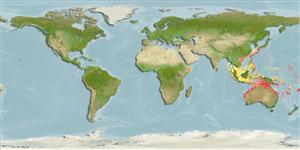>
Callionymiformes (Dragonets) >
Callionymidae (Dragonets)
Etymology: Synchiropus: Greek, syn, symphysis = grown together + Greek, cheir = hand + Greek, pous = foot (Ref. 45335).
Environment: milieu / climate zone / depth range / distribution range
Ökologie
seewasser demersal; tiefenbereich 23 - 75 m (Ref. 86942). Tropical
Western Central Pacific: northwestern Australia and New Caledonia.
Size / Gewicht / Alter
Maturity: Lm ? range ? - ? cm
Max length : 15.0 cm TL Männchen/unbestimmt; (Ref. 3132)
Rückenflossenstacheln (insgesamt) : 4; Rückenflossenweichstrahlen (insgesamt) : 8; Afterflossenweichstrahlen: 7. Head and body light grey, ventrally white, sides with small red blotches and streaks. First dorsal fin yellow or grey, with vertical yellow bars, white spots and streaks edged with black. Second dorsal fin light grey with horizontal yellow and white streaks on posterior half. Caudal fin with 2 wide, vertical, dark grey bars. Anal fin distally black. Preopercular spine with 4 to 11 small antrorse serrae on its dorsal margin and an antrorse spine at its base. First dorsal fin at least twice as high as second dorsal fin. Caudal fin in males without filaments (Ref 42832).
Lives on trawling grounds, often found on sand or rubble bottoms.
Life cycle and mating behavior
Maturities | Fortpflanzung | Spawnings | Egg(s) | Fecundities | Larven
Allen, G.R. and R. Swainston, 1988. The marine fishes of north-western Australia: a field guide for anglers and divers. Western Australian Museum, Perth. 201 p. (Ref. 3132)
IUCN Rote Liste Status (Ref. 130435)
Bedrohung für Menschen
Harmless
Nutzung durch Menschen
Tools
Zusatzinformationen
Download XML
Internet Quellen
Estimates based on models
Preferred temperature (Ref.
123201): 20.8 - 26.5, mean 24.5 °C (based on 38 cells).
Phylogenetic diversity index (Ref.
82804): PD
50 = 0.5000 [Uniqueness, from 0.5 = low to 2.0 = high].
Bayesian length-weight: a=0.01148 (0.00455 - 0.02896), b=2.92 (2.70 - 3.14), in cm total length, based on LWR estimates for this (Sub)family-body shape (Ref.
93245).
Trophic level (Ref.
69278): 3.5 ±0.4 se; based on size and trophs of closest relatives
Widerstandsfähigkeit (Ref.
120179): hoch, Verdopplung der Population dauert weniger als 15 Monate. (Preliminary K or Fecundity.).
Fishing Vulnerability (Ref.
59153): Low vulnerability (10 of 100).
